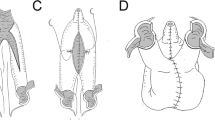Summary
Ureterneoimplantation (unilateral in 6 cases) was performed as palliative urinary diversion in 8 patients (age 64–81 years) due to locally advanced prostate cancer and bilateral ureteral obstruction (serum creatinine 2.1 to 9.8 mg. per dl.) between 1991 and 1995. In these cases the applipcation of a double-J-catheter had failed or a percutaneous nephrostomy was refused. Postoperative time of survival (237 days, 2 patients still living for 20 and 21 months after therapy), mortality (1 of 8 patients), morbidity and time to hospital discharge (26 days) are compared to the results of the published retrospective investigations concerning percutaneous nephrostomy. The opportunity of a natural micturition without external urinary diversion could be gained for a longer period of time (5 and 20 months) in 2 of 3 patients. The other patients with in situ double-j-catheters were drained sufficiently by a suprapubic cystostomy (serum creatinine postoperatively 1.3 to 2.0 mg. per dl.). Bilateral ureterocystoneostomy being more invasive than unilateral diversion showed no benefits and was no more performed since 1991. Ureterneoimplantation with comparable postoperative results to percutaneus nephrostomy seems to be a sufficient therapeutic possibility in patients with natural micturition, repeated catheter complications, refusal or failure of alternative urinary diversion.
Zusammenfassung
Eine Ureterozystoneostomie (6mal einseitig) als innere Harnableitung erhielten 8 Patienten (64–81 Jahre) zwischen 1991–1995 mit einem lokal fortgeschrittenen Prostatakarzinom und konsekutiven Harnstauungsnieren beidseits (Serumkreatinin 2,1–9,8 mg/%) nach frustranem Versuch der inneren Schienung und Ablehnung einer perkutanen Nephrostomie. Die postoperative Überlebenszeit (237 Tage bei zwei 20 und 21 Monate nach Therapie noch lebenden Patienten), Mortalität (1/8 Patienten), Morbidität und postoperative stationäre Aufenthaltsdauer (26 Tage) werden mit den Resultaten der publizierten retrospektiven Untersuchungen nach perkutaner Nephrostomie verglichen. Der Erhalt der natürlichen Blasenentleerung ohne äußere Harnableitung konnte bei 2 Patienten langfristig (ca. 5 und 20 Monate) erreicht werden. Die Übrigen wurden bei belassener innerer Schiene über einen suprapubischen Ballonkatheter suffizient abgeleitet (postoperatives Serumkreatinin 1,3–2,0 mg/%). Die beidseitige Neoimplantation erbrachte bei größerer Invasivität keinen Vorteil und wurde 1991 verlassen. Die zur Harnableitung durch perkutane Nephrostomie vergleichbaren postoperativen Ergebnisse lassen die Ureterozystoneostomie – bei Patienten mit erhaltener Miktion, rezidivierenden Katheterkomplikationen und Ablehnung oder Mißlingen einer anderweitigen Harnableitung – als suffiziente therapeutische Alternative erscheinen.
Similar content being viewed by others
Author information
Authors and Affiliations
Rights and permissions
About this article
Cite this article
Wawroschek, F., Hamm, M. & Rathert, P. Ureterneoimplantation as a safe and effective alternative of urinary diversion in locally advanced prostate cancer. Urologe [A] 37, 372–376 (1998). https://doi.org/10.1007/s001200050193
Published:
Issue Date:
DOI: https://doi.org/10.1007/s001200050193




